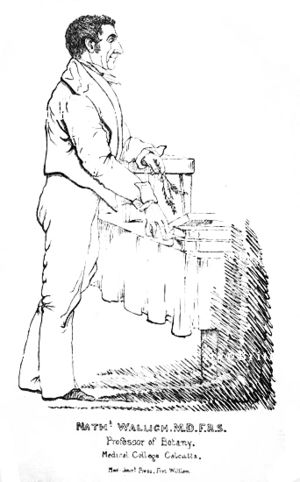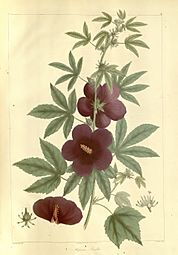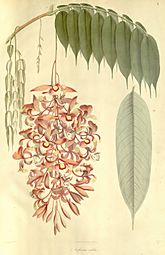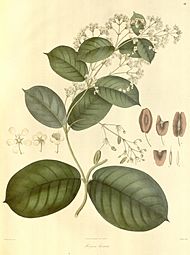Nathaniel Wallich facts for kids
Quick facts for kids
Nathaniel Wallich
|
|
|---|---|
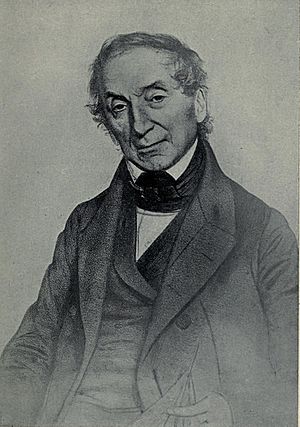
Wallich, from an old lithograph by T. H. Maguire
|
|
| Born |
Nathan ben Wulff
28 January 1786 Copenhagen, Denmark
|
| Died | 28 April 1854 (aged 68) London, England
|
| Alma mater | Royal Academy of Surgeons |
| Known for |
|
| Scientific career | |
| Fields |
|
| Institutions |
|
| Author abbrev. (botany) | Wall. |
Nathaniel Wolff Wallich (born January 28, 1786 – died April 28, 1854) was a surgeon and botanist. He was originally from Denmark but spent most of his career in India. He first worked in a Danish settlement near Calcutta and later for the British East India Company.
Wallich played a big part in setting up the Royal Botanic Garden, Calcutta. He found and described many new plant species. He also created a huge collection of dried plant samples, called a herbarium. These samples were then shared with other collections in Europe. Many plants were named after him because of his important work.
Contents
Early Life and Education
Nathaniel Wallich was born in Copenhagen, Denmark, in 1786. His birth name was Nathan Wulff Wallich. His father, Wulff Lazarus Wallich, was a merchant from a town called Altona, near Hamburg. His mother was Hanne Jacobson.
Wallich studied at the Royal Danish Academy of Surgery in Copenhagen. Here, he learned a lot about plants from his professors. He earned his diploma in 1806. Later that year, he became a surgeon in the Danish settlement of Serampore in Bengal, India.
Wallich's Career in India
Wallich sailed to India in April 1807 and arrived in November. At that time, Denmark was allied with Napoleon. This meant the British took over many Danish colonies, including Serampore. Wallich was briefly held captive by the British East India Company. However, he was released in 1809 because of his scientific knowledge.
Working for the East India Company
In August 1814, Wallich began working as an assistant surgeon for the East India Company. He also became the first superintendent of the Indian Museum.
Founding the Indian Museum
Wallich suggested creating a museum in a letter in 1814. He offered his help and some of his own collections for the museum. The Asiatic Society liked his idea and decided to open a museum. They made Wallich the honorary curator and superintendent.
The museum officially started on June 1, 1814. It grew quickly with Wallich's guidance and donations from private collectors. Wallich himself was one of the biggest donors, giving 42 plant samples to the museum by 1816.
Leading the Royal Botanic Garden
Wallich was also put in charge of the Royal Botanic Garden, Calcutta. He officially joined the garden in 1817 and worked there until 1846. He had to spend some time in Mauritius from 1811 to 1813 because he was not well.
In 1822, his friend Sir Stamford Raffles asked him to design a botanical garden in Singapore. Wallich traveled there but returned to Calcutta the next year.
Wallich created a huge list of over 20,000 plant samples. This list is known as the "Wallich Catalogue." The samples in this catalogue were collected by Wallich and other explorers. Today, Wallich's personal collection is kept at the Kew Herbarium in England. He also shared copies of his samples with other plant collections.
He wrote two important books: Tentamen Florae Nepalensis Illustratae and Plantae Asiaticae Rariores. He also went on many trips to find new plants. Wallich helped many other plant explorers who visited Calcutta on their way to the Himalayas.
The book Plantae Asiaticae Rariores had beautiful drawings. Artists from the Calcutta Botanic Garden created 256 of these drawings.
Recognitions and Awards
Wallich received an M.D. degree in 1819. He became an assistant to William Roxburgh, who was the East India Company's botanist in Calcutta. Wallich became very interested in the plants of India. He went on expeditions to Nepal, West Hindustan, and lower Burma.
From 1837 to 1838, Wallich was a professor of botany at the Calcutta Medical College. In 1821, he received an honorary doctor's degree from the University of Copenhagen. In 1826, he became a member of the Royal Danish Academy of Sciences and Letters.
He was also chosen as a Fellow of the Royal Society of Edinburgh in 1822. In 1828, he became a Fellow of the Royal Society of London. These were important honors for his scientific work.
Later Life and Legacy
Wallich's health got worse over many years. He even got cholera at one point. He finally had to leave his job in 1846 and move back to London. There, he became the vice-president of the Linnean Society of London. He had been a member of this society since 1818.
Wallich stayed in London until he passed away seven years later. He died on April 28, 1854, at the age of 68. He was buried in Kensal Green Cemetery.
A large part of Wallich's plant collections, known as the Wallich Herbarium, is still kept at Kew Gardens. Another part is at the Central National Herbarium in Calcutta. Together, these collections have about 20,500 plant samples. Wallich also wrote 35 scientific papers, mostly about plants.
Wallich's Family
Wallich was the uncle of a Danish zoologist named Theodore Cantor. Wallich married Juliane Marie Hals in 1812, but she died just two months later. In 1815, he married Sophia Collings. They had seven children together, but two of them died when they were very young. Their oldest son, George Charles Wallich, became a famous oceanographer.
Gallery
- Some images of plates from ''Plantae Plantae Asiaticae Rariores''
Plants Named After Nathaniel Wallich
|
|
|
See also
 In Spanish: Nathaniel Wallich para niños
In Spanish: Nathaniel Wallich para niños
- Plantae Asiaticae Rariores
Film
- Morten Skriver (director): "Nathanial Wallich & Botanikkens Imperium", Zentropa Real (2003)


